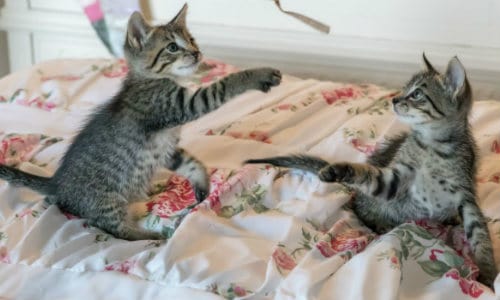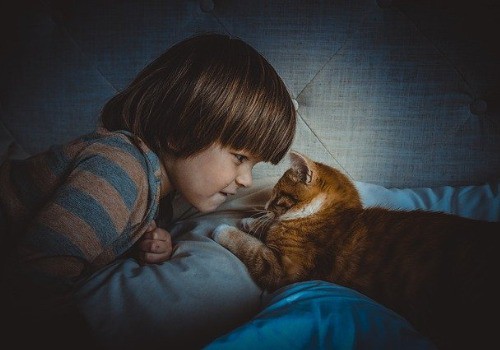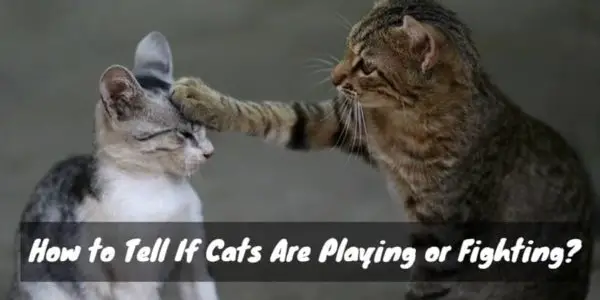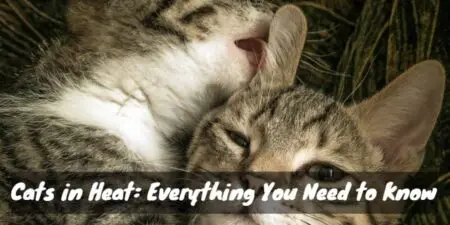Playtime is a vital part of every cat’s day. From kittenhood to old age, all cats require a way to release pent-up energy, get exercise and fulfill the need for socializing. Big cats and feral domestic cats can meet these needs at least partially through hunting and simply existing within a social hierarchy, but for the average housecat, play is the only outlet.
Owners of multiple cats may find that they have a hard time interpreting the relationships the cats have with one another. Cats can be notoriously difficult to read, especially when so much of their communication between each other goes unnoticed by us. And just as human relationships have their ups and downs, so too do cat relationships – things can be peachy one day and dire the next.
It’s understandable, then, that cat owners often find themselves wondering whether their cats are playing or fighting. Both activities are highly physical, involving the use of the entire body, and the exertion required of both can cause the cats to make some strange, sometimes alarming, noises.
So how can you tell if cats are simply having a play date or if they’re actually fighting? Is there any real danger or should you just let them have their fun? We may not be able to know exactly what’s going on in a cat’s mind, but with a little understanding of behavior and social structures we can tell the difference between a dash of fun and a display of aggression.
The Social Ladder: How Cats Decide Who to Play with
Family Ties

As soon as kittens are able to open their eyes and stumble around, they begin to play with each other. A cat’s drive to play is at its strongest when it’s very young, and siblings make very convenient playmates.
Being born together means that everyone is at a similar developmental stage, so there’s not as much danger of being overpowered. With Mom there to act as coach and maintain order, the kittens feel comfortable and secure enough to express themselves through play.
Playing with siblings is certainly fun, but it’s also critical to proper development. Many important skills are learned through play, and kittenhood is the safest time to learn them – claws and teeth do less damage, and being small and lightweight greatly decreases the chance of serious injury.
Under the watchful eye of their mother, the kittens are able to safely practice chasing, pouncing, biting and stalking. These are all skills they will need to survive on their own as adults.
This is part of why cat playing often seems like fighting: the same skills and techniques are used for both. Play is practice for fighting, like a self-defense class for cats. It also teaches them how to communicate with other cats and, when their mother intervenes, how to tell where their boundaries should lie.
[amazon bestseller=”cats tree”]
All Grown up

Once kittens grow up and head off into the world, they still like to play even if they don’t need to. How often they get to play depends on where they end up.
It’s easy to find a playmate when you’re surrounded by siblings, but adult cats don’t always want to make new friends. Naturally cautious, it takes time for cats to trust each other. Until they let their guards down a bit there’s no chance of playtime.
Young adult cats still have a strong drive to play, and may try to use it as a “getting to know you” activity. This tends to backfire, especially with older cats who are more versed in the ways of the world. Because cat play and cat fighting are so similar, it’s very common for a playful advance to be read as an attack, and responded to accordingly.
It may seem mean to refuse a request for play, but to the recipient it’s a matter of safety. Even when it’s playful in nature, roughhousing can get a bit violent, so if there’s not enough trust built up yet, it’s better to be safe than sorry. All it takes is one wrong move to get seriously injured; cats know this and protect themselves by reserving play for those closest to them.
A cat needs to find its place in the group and build trust with the other members before it has a shot at getting some playtime in. Often, other signs of bonding (such as grooming and sleeping with each other) will be shown before play ever occurs.
This is helpful knowledge to have when determining whether an encounter is playful or aggressive. If the cats don’t know each other, or if they don’t share a reciprocal bond, then it’s almost certainly not play.
Good Form: The Body Language of Play
It’s important to understand how cats use body language to communicate their moods and desires. Without this knowledge, discerning play from fight may not be possible. There are several telltale signs that a cat is not having a good time, and most of them are delivered via body language.
An Aggressive Stance
The most visible indicator of an aggravated cat is an arched back with fur standing on end and rear legs extended, pushing the posterior up. The tail will also become very fluffy, like a bottle brush, and flick back and forth with great intensity.
This powerful stance makes the cat look bigger and therefore more threatening – something that’s not necessary during play but vital during a fight.
Conversely, cats at play will keep their spines level and fur flat. Their tails may flick back and forth, but they won’t be fluffed up very much, if at all.
They may also crouch or lie down rather than stand, sometimes even rolling over onto their sides or backs. which a fighting cat would not do. The stomach is a very vulnerable area and cats won’t reveal it if they sense any danger.
Face off
Before a cat fight, there’s often a standoff: the cats will stand far apart from each other and stare at each other. They push their ears back (a protective move, as prominent ears could easily get hurt in a fight) and lock eyes, neither daring to break eye contact. It’s an important rule of fighting across the animal kingdom to always keep an eye on your opponent, and cats are no exception.
Playing cats will still maintain eye contact with each other, but not so fiercely; they’ll take breaks to lick themselves or check out their surroundings. Though they may push their ears back slightly here and there they won’t hold them in that position for extended periods of time. The differences in facial expressions can be subtle but telling, especially when determining whether a play session is about to go south.
Full Contact
A fight is serious business, and a fighting cat will try to stay as far away from its opponent as possible. The closer they are to each other, the greater the chance of getting hurt. If physical contact does occur, claws will be out and teeth will be bared – at that point, it’s no holds barred.
Because part of what makes play fun is the physical contact, cats at play are more likely to spend their time rolling around with each other. They may still begin the session with a brief staredown and take turns stalking each other, but they’ll tend to remain close together much of the time. If they’re not actively wrestling, they’ll at least be close enough to swat at each other (claws sheathed, of course) or pounce on top of one another.
Taking Turns
In a cat fight, there are no turns: if you have an opportunity to strike, you take it. The fight may not be evenly matched, and one cat may take on the role of aggressor, chasing and cornering its opponent. If one cat seems to be taking a bigger beating than the other, it’s likely a real fight.
Playing cats seem to have a greater concept of fairness. One may have the upper hand for a round or two, but will then let the other cat take charge. If they engage in a chase, they’ll take turns pursuing one another, rather than one cat continually running for its life from the other.
A fight may also be balanced in this way if the cats are equally skilled, but if they appear to willingly switch off roles, it’s just playtime.
Fighting Words: Vocalizing Intent
The Sounds of Play
Cats at play tend to be quieter than cats at war. They may meow here and there or even purr a little, especially during the rest periods they take in between rounds, but for the most part they’re surprisingly silent except for the thuds of their bodies and paws on the floor.
You may hear a hiss or two during play, and if you do it’s probably a good idea to keep an eye on the cats for a bit, but it’s not necessarily an indicator of a fight. Sometimes roughhousing gets, well, rough, and claws may be inadvertently extended or mouthing may get too toothy. When this happens, the other cat will usually respond with a hiss as a warning to tone it down a bit.
Usually the other cat will take the hint and back off a bit, perhaps letting its partner be the dominant one instead or switching from wrestling to chasing or stalking. In the event that it ignores the hiss and continues being rough, playtime may give way to a real fight.
Going Down Screaming
Fights, on the other hand, can get very noisy indeed. They often start off with hisses and low growls in the standoff phase, then devolve into yowls and screeches when contact is made. If there’s a lot of vocalizing, it’s probably going to get ugly – that is, if it hasn’t already.
Breaking It Up: What to Do When Cats Fight

When you see cats fighting, you’ll probably feel compelled to intervene, but getting physically involved in a cat fight is a bad idea for many reasons. You’re a lot bigger and stronger than a cat, and if you’re moving with force there’s a good chance you could hurt one or both of the cats. With you in the mix, the cats could get confused and injure themselves (or you) unintentionally.
Intervening from a distance is the safest way to break up a cat fight. Try to distract one of the cats with food, treats or toys, or chase one into another room and shut the door. If the cats are already engaged in combat, throwing a towel or blanket over them will sometimes startle them enough that they disengage, allowing you to pick one up in the towel and move it to another room to calm down.
[amazon bestseller=”cat toys”]
Sometimes the cats are so focused on their battle that no visual or tactile interventions will work. In this case, take advantage of their sensitive hearing by clapping or making another loud noise. This may alarm them enough that they instinctively run away, ending the fight.
"In ancient times cats were worshipped as gods; they have not forgotten this."
-- Terry Pratchett





